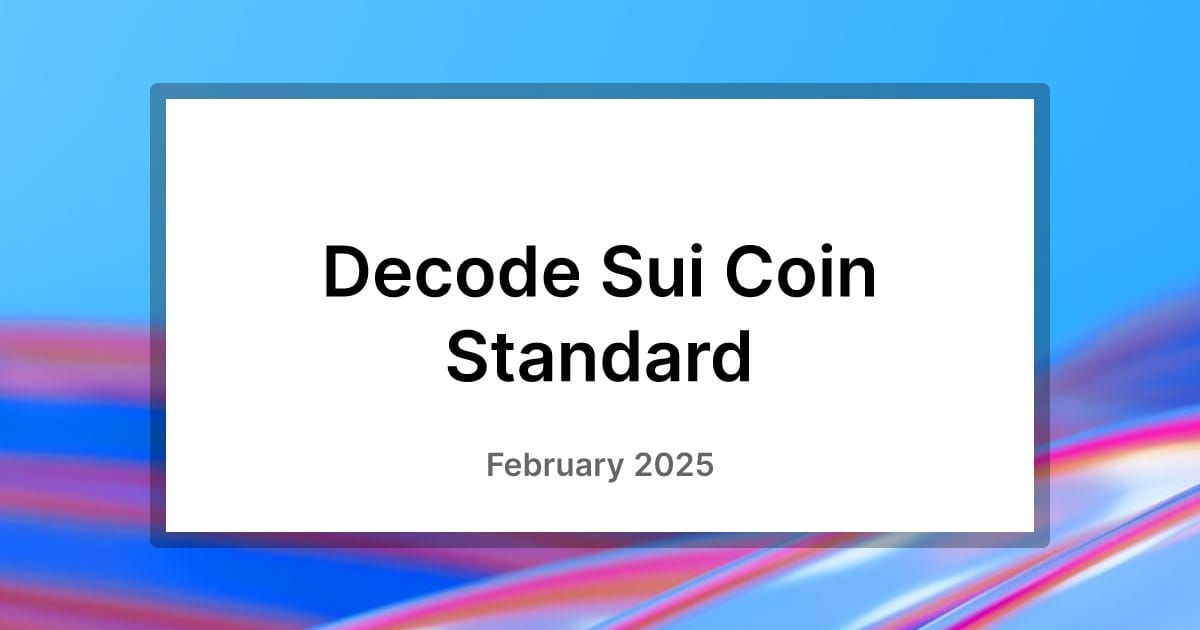Decode Sui Coin Standard: Simple Guide to Minting, Burning & Regulated Tokens

Source: Decode Sui Coin Standard | senn.fun
Sui coins use the Move programming language and an object-oriented design, differing notably from Ethereum’s ERC20 tokens. Here’s what you need to know:
Key Components of Sui Coins
- TreasuryCap: Central authority managing minting, burning, and total supply.
- CoinMetadata: Stores coin details like name, symbol, decimals, and icon URL.
Coin Operations
- Minting: Only the
TreasuryCapcan produce new coins, increasing total supply. - Burning: Destroying a coin deletes the object and reduces total supply accordingly.
- Splitting & Joining: Coins can be divided into smaller parts or combined to adjust balances.
- Zero Coins: Special zero-value coins act as placeholders without value.
- Regulated Coins: Support built-in regulatory controls, like deny lists and global pauses, restricting certain users from transacting.
How Sui Coins Differ from ERC20 Tokens
| Aspect | Sui Coin | ERC20 Token |
|---|---|---|
| Platform & Language | Built with Move, object-oriented | Solidity on Ethereum, balance mapping |
| Minting/Burning | Controlled by unique TreasuryCap | Defined in contract, usually owner controlled |
| State Management | Coins as unique objects with IDs | Balances stored in contract mapping |
| Advanced Features | Built-in deny lists, global pause | No native regulation; requires extra contracts |
| Limitations | No approval mechanism - only owner can transfer coin objects | Supports approvals allowing delegated transfers |
Creating and Managing Coins
- Create Currency: Generates unique
TreasuryCapandCoinMetadata. One-time witness ensures single issuance. - Mint: Authorized
TreasuryCapmints newCoinobjects representing balances. - Transfer: Relies on Sui’s object transfer; transferring coin ownership requires unique object ID.
- Burn: Coin objects are deleted, updating total supply downwards.
- Split & Join: Flexible balance modifications by splitting one coin into two or merging two coins.
- Divide into N Coins: Splits a coin into multiple equal parts, leaving any remainder in the original coin.
Zero-Value Coins
- Useful for placeholder purposes such as bids or empty balances.
- They can be created and destroyed without affecting total supply.
Regulated Currency V2: Enhanced Control
- Includes a DenyCapV2 object allowing the owner to manage a deny list.
- Addresses on the deny list cannot use coins as transaction inputs or receive coins.
- Supports global pause, disabling all transactions involving the coin type immediately, with delayed lifting after an epoch (~24 hours).
- Deny lists and global pause operate independently: clearing pause doesn't remove denied addresses.
Managing Deny Lists
- Addresses can be added or removed using
deny_list_v2_addanddeny_list_v2_remove. - Changes take effect immediately for sending and after one epoch for receiving coins.
Summary
Sui’s coin standard offers a novel, object-oriented token model with advanced built-in capabilities for minting, burning, splitting, and regulatory compliance through deny lists and global pauses. Its differences from ERC20 highlight new possibilities but also stricter transfer ownership rules due to the absence of delegated approvals.
For developers and project leads, understanding these fundamental mechanics is key to designing secure and compliant token systems on Sui.


